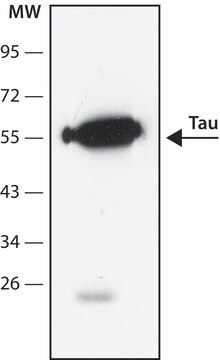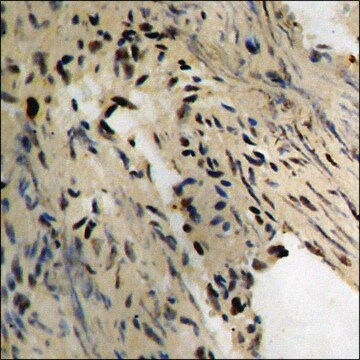추천 제품
생물학적 소스
rabbit
Quality Level
결합
unconjugated
항체 형태
affinity isolated antibody
항체 생산 유형
primary antibodies
클론
polyclonal
형태
buffered aqueous glycerol solution
종 반응성
rat, mouse, human
기술
microarray: suitable
western blot: suitable
UniProt 수납 번호
배송 상태
wet ice
저장 온도
−20°C
타겟 번역 후 변형
phosphorylation (pSer199/pSer202)
유전자 정보
human ... MAPT(4137)
mouse ... Mapt(17762)
rat ... Mapt(29477)
일반 설명
Tau (τ), also known as MAPT (microtubule associated protein tau), is encoded by the gene mapped to human chromosome 17q21.3. It is highly expressed in neurons, but is most prominent in axons.
Tau proteins are known as microtubule-associated phosphoprotein (MAP) and express mainly in neurons of central nervous system. It has a crucial role in tubulin polymerization and facilitates microtubules assembly and stability. The biological activity of tau proteins depends on degree of its phosphorylation. Anti-phospho-Tau (pSer199/202) antibody can be used in microarray and western blotting. It can also be used in immunoblotting. Rabbit anti- phospho-Tau (pSer199/202) antibody reacts specifically with human Tau (pSer199/202) (45-68 kD).
면역원
chemically synthesized phosphopeptide derived from the region of human tau that contains serine199 and serine202.
애플리케이션
Anti-phospho-Tau (pSer199/202) antibody produced in rabbit has been used in:
- immunocytochemistry
- immunohistochemistry
- western blot
Anti-phospho-Tau (pSer199/202) antibody (diluted 1:1000 in PBS containing 0.3% Triton X-100 and 0.5% BSA) can be used in immunocytochemistry for identification of protein aggregates. It can also be used as primary antibody (diluted 1: 3000) in immunohistochemistry.
생화학적/생리학적 작용
Tau (τ) plays an essential role in the assembly and maintenance of microtubule structure. Deletion of tau (τ) results in developmental delay and learning disability. The gene expression is associated with the development of Alzheimer′s disease (AD). Genetic variation in τ gene increases the risk of susceptibility to the sporadic tauopathies, progressive supranuclear palsy (PSP) and corticobasal degeneration.
물리적 형태
Solution in 100 μl Dulbecco′s phosphate buffered saline (without Mg2+ and Ca2+), pH 7.3, 50% glycerol, containing 1.0 mg/ml BSA (IgG, protease free) and 0.05% sodium azide. The amount of antibody is sufficient for 10 immunoblots.
면책조항
Unless otherwise stated in our catalog or other company documentation accompanying the product(s), our products are intended for research use only and are not to be used for any other purpose, which includes but is not limited to, unauthorized commercial uses, in vitro diagnostic uses, ex vivo or in vivo therapeutic uses or any type of consumption or application to humans or animals.
적합한 제품을 찾을 수 없으신가요?
당사의 제품 선택기 도구.을(를) 시도해 보세요.
신호어
Warning
유해 및 위험 성명서
예방조치 성명서
Hazard Classifications
Eye Irrit. 2 - Skin Irrit. 2
Storage Class Code
10 - Combustible liquids
WGK
WGK 3
Flash Point (°F)
320.0 °F - closed cup
Flash Point (°C)
160 °C - closed cup
시험 성적서(COA)
제품의 로트/배치 번호를 입력하여 시험 성적서(COA)을 검색하십시오. 로트 및 배치 번호는 제품 라벨에 있는 ‘로트’ 또는 ‘배치’라는 용어 뒤에서 찾을 수 있습니다.
Yan-Bin Shi et al.
Frontiers in aging neuroscience, 12, 596894-596894 (2020-12-29)
Dystrophic neurites (DNs) are found in many neurological conditions such as traumatic brain injury and age-related neurodegenerative diseases. In Alzheimer's disease (AD) specifically, senile plaques containing silver-stained DNs were already described in the original literature defining this disease. These DNs
Tian Tu et al.
Frontiers in aging neuroscience, 12, 93-93 (2020-06-02)
Amyloid plaques and neurofibrillary tangles (NFTs) are hallmark lesions of Alzheimer's disease (AD) related to β-amyloid (Aβ) deposition and intraneuronal phosphorylated tau (pTau) accumulation. Sortilin C-terminal fragments (shortened as "sorfra") can deposit as senile plaque-like lesions within AD brains. The
Feng-Qin Zhou et al.
Alzheimer's research & therapy, 10(1), 40-40 (2018-04-25)
Alzheimer's disease (AD) is a devastating neurodegenerative disorder bearing multiple pathological hallmarks suggestive of complex cellular/molecular interplay during pathogenesis. Transgenic mice and nonhuman primates are used as disease models for mechanistic and translational research into AD; the extent to which
Rodrigo S Chaves et al.
BMC neuroscience, 11, 144-144 (2010-11-12)
Protein aggregates containing alpha-synuclein, beta-amyloid and hyperphosphorylated tau are commonly found during neurodegenerative processes which is often accompanied by the impairment of mitochondrial complex I respiratory chain and dysfunction of cellular systems of protein degradation. In view of this, we
Xia Hu et al.
Frontiers in neuroanatomy, 11, 45-45 (2017-06-24)
Genetic variations in the vacuolar protein sorting 10 protein (Vps10p) family have been linked to Alzheimer's disease (AD). Here we demonstrate deposition of fragments from the Vps10p member sortilin at senile plaques (SPs) in aged and AD human cerebrum. Sortilin
자사의 과학자팀은 생명 과학, 재료 과학, 화학 합성, 크로마토그래피, 분석 및 기타 많은 영역을 포함한 모든 과학 분야에 경험이 있습니다..
고객지원팀으로 연락바랍니다.








